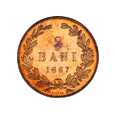Eneolitihc pendants made of Canis Familiaris L. mandibles
Texts & photos: dr. Cătălin Lazăr, dr. Adrian Bălășescu
Place of discovery: Sultana-Malu Rosu tell, Calarași county; dwelling L14. Culture: Gumelnita. Dating: 4500-3900 B.C . Material: bone. Techniqe: grinding, drilling. Mandible dimensions: 1. L - 121 mm, average thickness - 10 mm; 2: L - 121 mm, average thickness - 11 mm.
THE MAN AND THE DOG. A MILENARY RELATIONSHIP
The history regarding the relationship between humans and dogs seems to trace its roots back to more than 20.000 years ago as it is proven by several archaeological discoveries made throughout the entire Eurasian space, from the Altai Mountains to France. This prolonged interaction is expressed, archaeologically and ethnographically, through a preferential treatment of the dog, sometimes worshiped, buried in tombs, mummified, incinerated or sacrificed in rituals.
The dog – Canis Familiaris L. – is considered the oldest animal to be tamed by humans. Canine bone remnants are present in most fauna samples that have been studied. The species was raised mainly for practical reasons: the protection of herds and houses, for hunting, or simply as a companion for humans.
Various special burial ceremonies for dogs, such as those characteristic of the Siberian Neolithic, dating back to 7000 B.C., entitled experts to state that some animals, with special histories, were treated as “persons”, with “souls”; in consequence, after death, burial rituals for dogs were similar to those for humans. Regarding the common burials of dogs and humans such as those of the Italian Neolithic or from North-America, the hypothesis that in the afterlife dogs had the same role they had probably had in life, of protectors and helpers of the buried individual, was invoked.
In certain communities, it played a key role as a mediator with the spiritual world. For example, at Mkako, in Cameron, dogs were used in order to banish malefic spirits chasing the neophytes in the woods, during the initiation. However, within the same communities, dogs were sacrificed and eaten during burial ceremonies after the death of an important member of the society or of an adolescent.
Nevertheless in various prehistoric habitats, from across the globe, it was noticed that the species Canis familiaris was used as source of alimentation if we take into account the existence of cutting marks (systematic defleshing and disarticulation); the fur was used as well, based on the skinning marks on various bone fragments resulted.
The long and complex relationship between humans and dogs is very well reflected by the words of Claude Levi-Strauss (1971): „le singe est proche de l'homme selon la nature, par ressemblance physique, comme le chien est proche de l'homme selon la culture, par contiguïté sociale”.
THE PENDANTS DISCOVERED IN SULTANA - MALU ROȘU
The two pendants made out of dog mandibles (Canis familiaris L.) which are the subject of this article, were discovered in 2010, in a tell settlement from Sultana-Malu Roșu, Călărași county. This is one of the earliest settlements attributed to the Gumelnița culture (around 4500-3950 BC) on the present territory of Romania, which has been the subject of scientific research since 1923. The tell is located on the right shore of lake Mostiștea, not far away from the Sultana village, about 7 km from the Danube.
The two pendants were discovered in the same area as dwelling L14, which was a burnt dwelling located in the eastern extremity of the prehistoric settlement of Sultana, measuring about 6 x 8 m and oriented N-S. The construction technique is based on a wooden framework; on the northern and western sides there exist foundation trenches, while on the other two sides the walls were erected directly on the ground. The dwelling had only one room, the inventory retrieved was typical for Gumelnița communities (bone, silex and horn tools, grinders etc)
The tirst of the two pendants made out of dog mandibles (Canis familiaris L.) was discovered at the base of the northern foundation trench (C1/2010) of the L14 dwelling, which measured 5.30 m in length, between 0.45 and 0.59 in width and 0.40 in depth, taking into consideration the ground level at the time when the dwelling was erected (-3.14 m compared to ground level of the archeological excavations). The pendant is made out of a right-side mandible which is complete, the alveoli containing the teeth P4, M1 și M2. The lingual side (internal) shows many traces of secondary roots that might suggest that this part of the mandible was located closer to the surface of the ground at some point, while the lateral (external) side of the mandible is much better preserved, suggesting that it was not so affected by various taphonomic conditions. The age of the animal was determined based on the level of degradation of the M1 tooth, which is stage C according to the system proposed by Horard-Herbin (1997), suggesting an animal of intermediary age, a sub-adult. From a technological point of view, the item is interesting and unique due to the fact that on the coronoid process there is a perforation, made by combining the rotation with indirect percussion. The role of this perforation, based on the microscopic analysis and the degradation marks identified, was that of hanging, wearing and/or suspending. The item was dated through the radiocarbon method, obtaining an absolute age of 5570 ± 40 BP (Poz-52983), that might suggest a chronological interval ranging between 4466-4342 calBC (93.9% probability).
The second mandible was discovered at abandonment level of dwelling L 14, in its western extremity, 2.56 m deep below the ground level of archeological exploration. This level of abandonment of the dwelling L14 highlights another chronological moment of the house, subsequent to the time it was still in use. The pendant was made out of a relatively intact left side mandible with no teeth in the alveoli (I1-M3). The mandible's angular process is broken. The item is less damaged by the vegetal roots, but it has certain smooth cracks in the cortical bone. The absence of teeth prevents us from accurately estimating the age, but the fact that all permanent teeth had come out might suggest that the animal was approximately 6 months old (Schmidt, 1972). On the lingual side (internal) close M2 and M3 were noticed two smooth oblique cutting marks, one of them measuring 13.2 mm (close to M2) while the other 9.9 mm (close to M3), that might suggest the adjacent tissue was detached from the bone. Regarding this item we can specify that it shows only skinning marks, which indicates the intention of collecting just the fur; so far in the faunal environment of Sultana (NR=369) no other dog remains with anthropogenetic traces were identified (NR=13). This aspect should not surprise us because in Gumelnița culture this sort of dog remains with anthropogenetic marks (fleshing, disarticulation and skinning) were found in various settlements: Bordușani Popină, Hârșova, Măriuța, Vitănești și Taraschina (Bălășescu et al., 2005a, 2005b; Bălășescu & Radu, 2011). The habit of using and consuming this mammal is attested in the Boian culture as well (preceding the Gumelnița culture), such evidences having been found in Isaccea-Suhat, Siliştea-Conac, Hârşova and Izvoarele (Bălășescu et al., 2004). Similarly to the previous item this mandible too presents a perforation on the coronoid bone, which was made through rotation from both sides of the mandible. The entire surface of the lingual is smooth, probably due to the friction with various substrates (clothing, leather etc).
From a morphological and biometrical point of view, the two items are different and originate from different individuals. The biometric data fall within the values known for the Gumelnita culture (Bălășescu et al., 2005a). Therefore an estimation of basal cranial length according to the Dahr index revealed similar values for the two mandibles analyzed: 145.1 mm (mandible 1) and 145.8 mm (mandible 2), while the Brinkmann index reveals a relatively large difference between the two items: 144.5 mm (mandible 1) and 152.3 mm (mandible 2). According to Dahr index (average 131.9 mm, n=92, limits 98-179 mm) and the Birkmann index (131.4 mm, n=57, limite 110.1-155 mm) these values are higher than the average found for the Gumenlnița culture on the territory of Romania and fall within the observed limits..
Concerning the two mandibles discovered in Sultana, the human intervention in order to reshape them was minimal. The sole intention was to hang them, by producing a perforation, while the rest of the mandible remained untouched, thus being possible to recognize both the species and the type of bone, aspects that might suggest their role in transmitting a visual message, with unknown connotations. However, according to the data identified using a microscope, we might estimate that they were suspended for a long period of time, which produced changes in the morphology of the perforations and the condition of the surface, as a result of the contact with another material (leather, clothing?).
Therefore, given the results of archaeological, zoo-archaeological, and techno-functional studies and as well of archeological data accessible at this moment regarding the Neolithic period in Europe, we can assume that the two pendants made out of dog mandibles (Canis familiaris L.) are unique. The only similar items were discovered in the Misigtoq archaeological site (Greenland), being dated between 1600 and 1800 (Morey, 2010).
Apart from the practical function of the two pieces found in Sultana, which was proven through their interdisciplinary analysis, they unequivocally had a symbolic value. This hypothesis is certified by their unique character and by the circumstances in which they were discovered – in association with a burnt and abandoned house. Therefore, based on the gathered information we can state that the two pendants made out of dog mandibles (Canis familiaris L.) are symbolically connected to the entire evolutionary cycle of dwelling L14, its construction, its existence and to its desertion, probably representing items connected to those who used to live in this house.
The sacrificing of these two unique items, in two key moments of the prehistoric house – the foundation and the abandonment represent an important aspect regarding the symbolic, ritual, and mystic value of these artifacts.
Also, these two pendants might be associated to the ancestral role of the dog – defender of the household - and to certain subsistence activities characteristic to the communities of Gumelnița culture (hunting and husbandry).
Moreover, if we take into consideration the anatomical elements used in the manufacture of the two pendants – mandibles, which are components of the head, and have a complex symbolism within the various prehistoric communities, the mandibles could be amulets with distinct apotropaic value, as it happens in in Mongolia where the most valued bones for making amulets belong to the cranium (especially the teeth and jaws), are considered bones of might because animals use them to attack and defend themselves.
The religious connotations of these two artifacts must not be ignored. Thus, the dog could represent in Sultana the totem of the clan, as in the Solomon Islands, or for Native Americans (Mohicans, Algoquins) or Arunta aboringinals, where many clans have the dog as totem. Moreover, in the Solomon Islands, the dog appears in creation myths, being the one who, legends say, taught people how to cultivate land, build their homes and boats and eat meat.
In conclusion the two pendants made out of dog mandibles (Canis familiaris L.) that were discovered in the prehistoric settlement of Sultana, have, besides their unique typological and technological character, a complex symbolic value, which represents a message sent through time by human communities who lived 6000 years ago. At the same time, the pendants make us think about the the complexity of those prehistoric communities, especially from the perspective we regard, perceive and analyze them.


















